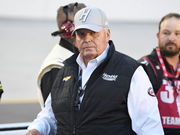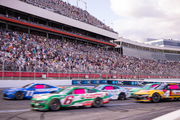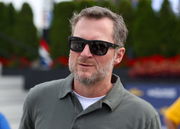
Imago
July 2, 2023, Chicago, Illinois, USA: NASCAR, Motorsport, USA Cup Driver, AJ ALLMENDINGER 16 races for position for the Inaugural Grant Park 220 on the Chicago Street Course. Chicago USA – ZUMAries 20230702_mda_a161_235 Copyright: xLoganxTxArcex Image Credits: Imago

Imago
July 2, 2023, Chicago, Illinois, USA: NASCAR, Motorsport, USA Cup Driver, AJ ALLMENDINGER 16 races for position for the Inaugural Grant Park 220 on the Chicago Street Course. Chicago USA – ZUMAries 20230702_mda_a161_235 Copyright: xLoganxTxArcex Image Credits: Imago
With ongoing charter negotiations and media rights in the balance, NASCAR might witness several changes in the coming years. But one question remains on every racing fan’s mind. Will more cities be transformed in the future similar to Chicago this year? In a press conference during the Race Industry Week on Monday, NASCAR President Steve Phelps divulged the racing body’s present stance on additional street courses.
Watch What’s Trending Now!
The thrill and excitement of watching racecars compete against the backdrop of the Chicago skyline was unlike any other witnessed in recent history. However, the mammoth event was not a financial success for NASCAR, and that would certainly be taken into consideration in the coming years.
ADVERTISEMENT
Chicago was a calculated risk that paid off, as per Steve Phelps
With the advent of the digital age, media visibility has become quintessential for the greatest of organizations, and NASCAR is no exception. The premier run of the Chicago Street Race came as a breath of fresh air amidst the falling viewership of the sport. The race undoubtedly drew international attention. The global appeal was magnified by the triumph of debutant New Zealander, Shane Van Gisbergen. It opened doors for other drivers from outside the States to bring their unique expertise into stock car racing. This would, over time, invariably lead to an increased interest in those countries as well. But what about the track itself?
The city spent $3.5 million and only received $620,000 in return. NASCAR reportedly poured over $50 million from the conceptualization to the execution of the race, which was ultimately cut short due to rain. And now Steve Phelps has admitted to heavy losses as well. So what was gained in the end? According to Phelps, publicity is the name of the game. As reported in Speed Sport, the NASCAR President claimed, “Having a calculated risk like having the Chicago Street Race is a risk that I felt we should take. We lost a ton of money on that race, but that was the best money we spent.” He came to that conclusion based on NBC ratings.
Watch this story: NASCAR’s Historic Track on the Brink of Extinction
ADVERTISEMENT
“It was the second highest-rated race we had all year,” Phelps further said. “People were interested in tuning in to see what was going to happen, particularly the casual fans. Our hardcore fans are going to tune in anyway. They are the best fans in the world, but the casual fans that drive those numbers.” The hype surrounding the race cannot be denied. But perhaps the novelty factor also played a part in the enhanced ratings. In order to avoid losing viewership on account of repetition, Phelps stressed balancing the current schedule to retain historic tracks, interspersed with a few adventurous ideas.
Top Stories
Rick Hendrick Strikes Fear in NASCAR Fans With Chevy’s New “Illegal” Car

New Charter Deal Triggers ‘Financial Frenzy’ as NASCAR Teams Set for Massive Payday

Martin Truex Jr’s Former Crew Chief Ends 12-Year Fight In Huge Personal Announcement

Denny Hamlin Gloats as Jim France Forced to Eat His Words Against Rick Hendrick & Co.

Dale Jr. Reveals How Permanent Charters Could Turn NASCAR Into a Billionaire’s Club With a Brutal Reality Check

ADVERTISEMENT
NASCAR hopes to retain the unique selling point of street courses
“I’m not suggesting that we are going to have five street races,” Steve Phelps clarified in his address. At the same time, he indicated that NASCAR would inculcate the Chicago Street Race or explore other street courses in the future as well. Phelps confirmed, “I do foresee in the future that we are going to have one street race, maybe two?”
However, he was aware of the possibility of the novelty fading off. He warned, “When you create something special and you replicate it again and again, it is going to stop being special.” This is why the governing body will seek other locations instead of having multiple street races in the same place.
.@StevePhelps on @NASCARChicago: "We lost a ton of money on that race, but that was the best money we spent. … People were interested in tuning in to see what was going to happen, particularly the casual fan." – @SpeedSport https://t.co/W8TghhanpS
— Adam Stern (@A_S12) November 27, 2023
ADVERTISEMENT
Phelps assured that longtime tracks such as Atlanta and Richmond will always be included but in order to stick to the 36-race schedule, NASCAR might forego the tradition of two races on the same track in one calendar year to pave the way for street courses that would attract a larger fanbase.
ADVERTISEMENT
ADVERTISEMENT
ADVERTISEMENT

